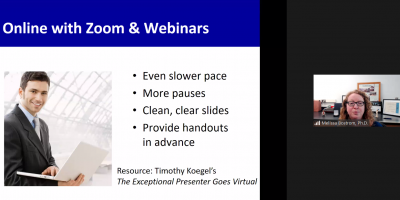
On February 24th, students in the Statistical Science department’s ProSeminar course participated in a seminar conducted by Dr. Melissa Bostrom. Dr. Bostrom, who is the Assistant Dean of Graduate Student Professional Development at Duke, directs the Professional Development Series, Emerging Leaders Institute, and the Duke OPTIONS project, all of which aid in preparing Graduate School students to perform as effective leaders at Duke and in their professional careers.
As a leader in the professional development space, Dr. Bostrom has gained specific expertise in delivering presentations, and ProSeminar students had the chance to hear her perspective on what makes a presentation effective. The ProSeminar course is primarily comprised of MSS students, many of whom will work in industry or continue in academia after the program. In either case, understanding how to deliver an effective presentation is an incredibly useful skill.

During the seminar, Dr. Bostrom touched on how to structure an effective presentation, how to deliver with confidence, and how to create visual impact. The seminar focused on the example of TED Talks, which provide useful case studies for effective presentations, and model how both industry and academic presentations can be made more engaging. Dr. Bostrom highlighted the importance of identifying the purpose of the presentation and context, and specifically tailoring this to the demographics of the audience. She also explained that when delivering content, non-verbal delivery can be just as important as verbal delivery and slide content.

In discussing what makes both a successful presentation and a successful presenter, Dr. Bostrom did not fail to take note of the medium through which many presentations must currently take place - that is, through virtual avenues rather than in-person. Nevertheless, the core of Dr. Bostrom’s message still rang true as she emphasized that the components that construct an effective in-person and virtual presentation are one and the same. Additionally, she gave tips on how to adjust for a virtual presentation, advising students to go even slower than they would in an in-person setting, paying extra attention to the visual presentation of their slides, and even suggested providing informational handouts in advance.
Given the highly technical and knowledge-intensive nature of a field like statistical science, the merit of building soft skills, especially in relation to presenting and communicating information, can often go unnoticed. At the graduate level, statistical science students are used to an environment in which many (if not all) of their peers are studying the same subject, are similarly technically-inclined, and have a kindred passion for statistics. Oftentimes there is no need to consider an audience that hails from a different background.
In reality, the study of statistics has a much broader purpose - it is a form of storytelling through data, a form of understanding the world and how data functions within it. Whether students decide to work in industry or continue on in academia, they must learn how to make full use of the tools that allow their findings to take root and come to life in the hands of those they are offered to, whether that audience is technically-inclined or not. Dr. Bostrom’s presentation not only echoed this sentiment, but provided students with the skills and tools needed to work towards becoming an engaging and effective presenter.
Just as an effective presentation is able to blossom into a compelling story in any field, it is through the amalgamation of these skills that a successful statistician can piece together their findings to tell a proper story with data.
Authors: MSS Students Sarah Mansfield and Aasha Reddy